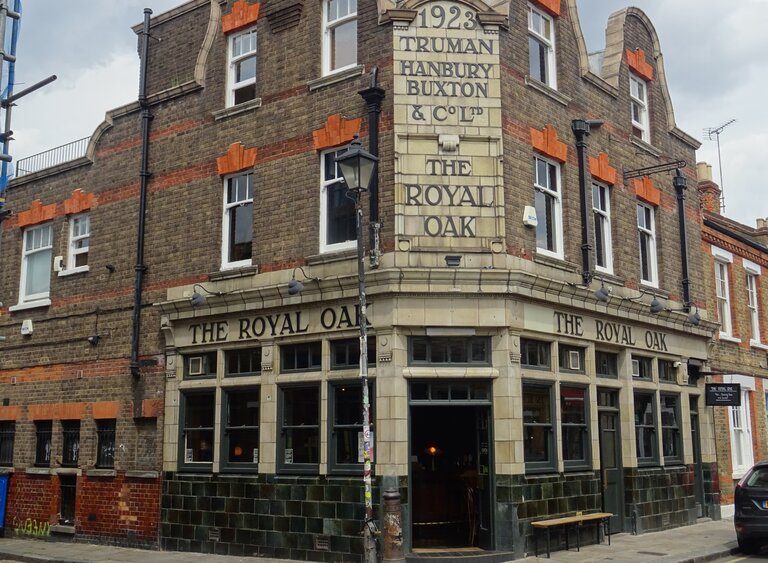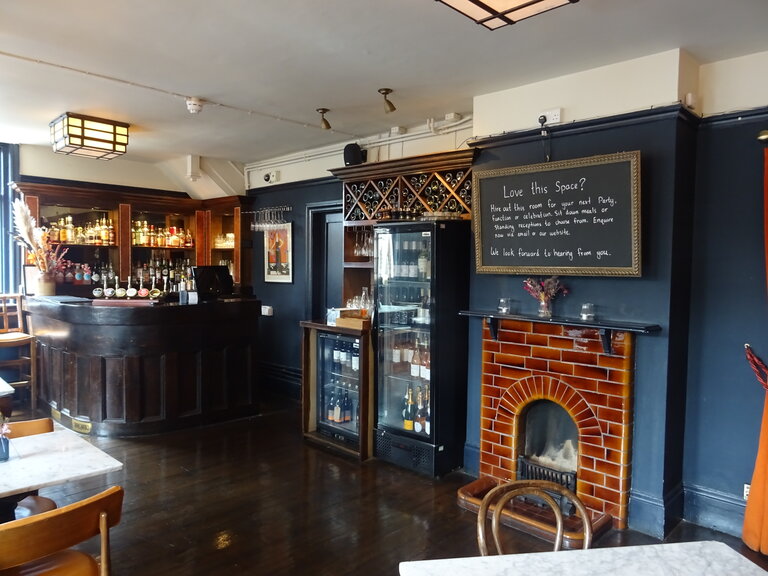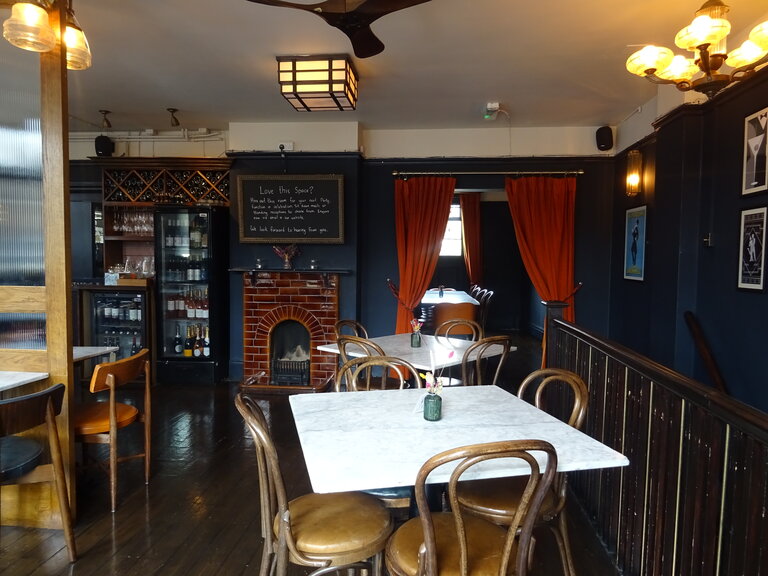Royal Oak
73 Columbia RoadBethnal Green
E2 7RG
This pub is not only a grade II listed building, it is also a One Star pub on the Campaign for Real Ale’s (CAMRA) National Inventory with an interior of special national historic interest, and the description is as follows: "Two storey of brick built 1923, probably by A E Sewell, for Truman’s brewery. The ground floor exterior is entirely clad in cream faience above sill level, and in green tile below. ‘The Royal Oak’ in faience is on the fascia on both street sides and in a framed panel above the corner door is. Above that a panel is inscribed ‘1923 / TRUMAN / HANBURY / BUXTON / & CO LTD’. There is a second double door centrally situated on the Columbia Road side with ‘BOTTLE & JUG’ etched into the glazing in both panels.
Originally there were partitions creating a public bar, off-sales, another bar, and a dining room at the rear right where the floor is boarded (which was likely to have been carpeted) – the rest having a parquet block one – but all the partitions have been removed so the interior is now open plan. The original central island bar servery with a fielded panelling front survives but only the lower part of the island gantry style bar back survives (and a lot of shelving lost to fridges), the top section having been removed.
Fielded panelling lines the walls to three-quarters height, and in certain areas has the names of beers inlaid - ‘Trumans Eagle Ale’, ‘Trumans Imperial Stout’, ‘Trubrown Ale’, ‘Ben Truman’, ‘Barley Wine’, ‘Trumans Burton Brewed Bitter’, and ‘Mild Ales’. However, the ‘Ben Truman’, ‘Barley Wine’, and ‘Mild Ales’ are on pieces of wood added to the panelling whereas the others are gilt lettering directly onto the panelling and look modern additions. Also on the walls lining the exterior is more fielded panelling topped with a row of green tiles under the windows, that can be opened vertically in summer.
In this rear right former dining room area there is a fireplace with a panelled timber surround (no panelling above the fireplace) and in the former public bar near the right hand entrance is a second fireplace with a brown glazed brick surround and is a less elaborate piece reflecting the lower status of the room. The ceiling is white Vitrolite panelling with timber ribs with small square bosses to the corners. Toilets are modernised throughout but do have modern light green brick shaped tiles throughout floor to ceiling.
From the right hand door is a lobby (with a door to/from the public bar) and staircase to the first floor with a small section of panelling on the left hand side (modern handrail). The main room of the first floor has a bare wood floor, is open plan, and (uniquely in London?) retains an inter-war curved fielded panelled bar counter (modern top) and some modest shelves (age?) for a bar back. The room has two fireplaces: one has a simple painted oak surround with delicate mouldings and red tiling; the other has brown glazed brick and a timber mantel shelf. Note the old gas fitting near the top of the stairs to the first floor."
The listing description is as follows: “Reasons for Designation: The Royal Oak public house, built 1923, probably designed by A E Sewell for Truman’s Brewery, is listed at Grade II for the following principal reasons: * Architectural interest: a traditionally-styled façade using rich materials and characterising the Truman’s brand, probably by one of the leading pub architects of the period; * Intactness: a largely unaltered exterior occupying a prominent position in the heart of the Colombia Road Flower Market; * Interiors: a well-surviving, restrained scheme of interior decoration on the ground floor, with good-quality inlaid panelling and a Vitrolite ceiling, and on the first floor the unusual survival of a bar counter.
History: Inter-war ‘improved’ or ‘reformed’ pubs stemmed from a desire to cut back on the amount of drunkenness associated with conventional Victorian and Edwardian public houses. Licensing magistrates and breweries combined to improve the facilities and reputation of the building type. Improved pubs were generally more spacious than their predecessors, often with restaurant facilities, function rooms and gardens, and consciously appealed to families and to a mix of incomes and classes. Central, island serveries with counters opening onto several bar areas allowed the monitoring of customers and also the efficient distribution of staff to whichever area needed service. Many, although not all, of the new pubs were built as an accompaniment to new suburban development around cities, and a policy of ‘fewer and better’ was followed by magistrates both in town and on the outskirts. A licence might be granted for a new establishment on surrender of one or more licences for smaller urban premises. Approximately 1,000 new pubs were built in the 1920s – the vast majority of them on ‘improved’ lines - and almost 2,000 in the period 1935-39. Neo-Tudor and Neo-Georgian were the favoured styles, although others began to appear at the end of the period. The Royal Oak was an early example of a pub improvement project undertaken by the east London brewery Truman’s, founded c1666. Dating from 1923, it was a rebuilding on the site of an earlier pub of the same name that was licensed from at least 1842. The earlier pub was clearly part of the early development of Columbia Road which was built up from 1830, and formed the corner-piece of a terrace of modest, two-storey houses to the east. A plan from c1900 shows stabling provision to the rear, accounting for the unusual length of the Royal Oak’s plot, which runs north-west to what was once Providence Yard (now part of Ezra Street). No plans of the 1923 rebuilding are known to survive, but on stylistic grounds it is very likely to have been designed by Truman’s lead architect, Arthur Edward Sewell (1872-1946). Sewell, a licentiate of the RIBA, was the principal architect and surveyor for Truman’s throughout the inter-war period; he was initially employed by the brewery in 1902 and designed at least 40 pubs for the firm; his last known work, the Royal George near Euston, was undertaken in c1939. He was a designer of some note, his public houses – mainly located in or just outside of London – regularly being featured in architectural journals of the time. Sewell’s pubs were generally designed in a simple form influenced by Neo-Georgian, Arts and Crafts and Moderne design, though he was also comfortable working in the Neo-Tudor style. A number of pubs by Sewell have been listed, including the Railway Hotel, Barnet (1930-31), the Ivy House, Southwark (c1936), the Royal George, Camden (1939-40) and the Golden Heart, Tower Hamlets (1936), all at Grade II. It is likely that the ground floor of the Royal Oak would originally have been divided into at least four separate bar rooms; partitions have since been removed to create an open plan. An early photograph of the pub shows that the corner entrance led into the saloon bar; this is named on a hanging sign that was originally located adjacent to the doorway, as well as on the door’s etched glass. Beyond this, to the north-west, was what was probably a saloon dining room. The saloon bar was divided by the centrally placed off sales compartment from what was almost certainly a public bar, entered through the single doorway on the right of the pub’s main façade. To the rear of this is likely to have been a games or dining room. A central servery was accessible from each of these spaces, and to the centre of the bar was likely to have been a publican’s office, the walls of which would have created a bar back and obscured lines of sight across the bar between the separate rooms. It appears that there was a kitchen located – as remains the case today – in the single-storey projection to the rear. The ground floor windows, formerly containing etched glass, have been replaced, though the etched glass in one pair of doors survives. Along with the Birdcage at 80 Columbia Road, the Royal Oak has a close association with the famous Colombia Road Flower Market and operates as an ‘early pub’, serving traders and customers of the market from nine o’clock on Sunday mornings. There has been a street market on Columbia Road since the C19, and it gradually evolved as a flower market, moving from Saturday to Sunday as the area’s Jewish population increased. By 1900 it was one of the largest flower markets in London, and in the post-war period it grew in popularity and fame, and by the 1980s was of international repute. The high rate of survival of the Royal Oak, the Victorian housing along Columbia Road and the adjoining Ezra Street, with its cobbled surface, have led to the Royal Oak being featured in a series of films set in wartime or 1950s London, as well as more recent British gangster films, most notably ‘The Krays’ (1990) and Guy Ritchie’s ‘Lock, Stock and Two Smoking Barrels’ (1998). The pub featured heavily in ‘Goodnight Sweetheart’, a BBC television series which ran for six seasons between 1993 and 1999. It also features in scenes for Brian Helgeland’s forthcoming crime thriller ‘Legend’, another dramatisation of the lives of Ronald and Reginald Kray.
Details: MATERIALS: the pub is built from brown and buff London stock brick with red brick dressings and cream faience. Truman’s distinctive mottled green tiling is used on the principal elevations, and brown glazed brick to the return elevation and boundary wall.
PLAN: the building occupies a corner plot at the junction of Columbia Road and Ezra Street. The open-plan bar is at the southern end of the building and ancillary rooms to the rear. There are three public entrances on the Columbia Road elevation which would have led into different bar rooms, an off-sales compartment, and a staircase leading to the first-floor club room.
EXTERIOR: the building is two storeys with an attic above the front two bays, and a single-storey range to the rear. The ground floor of the bar area is entirely clad in cream faience above cill level, and in green tile below. It is heavily glazed with pairs of one-over-one sash windows in faience architraves forming mullions and transoms, containing one-over-one light sashes with three lights above the transom. Cills are flush with the façade and are formed of curved green glazed blocks. The southern corner of the building is canted and forms a centrepiece to the south-east and south-west elevations; there is a half-glazed double door with two-over-one panes, and a four-pane overlight with vertical glazing bars. The lintel of the architrave is moulded faience, and is in line with the transoms of the windows to either side. There is a second double door in the centre of the south-east elevation with ‘BOTTLE AND JUG’ etched into the glazing, and a single half-glazed door to far right. Shallow corbels with circles and guttae project between the windows beneath a fascia which has egg and dart mouldings and a cornice. The name of the pub projects, also in faience, from the fascia and from a framed panel above the door in the canted bay. Above that a panel is inscribed ‘1923 / TRUMAN / HANBURY / BUXTON / & CO LTD’, beneath a segmental arch with shaped copings and kneelers with guttae. The south-west elevation continues beyond the bar rooms in slightly less sumptuous materials: it has brown glazed brick beneath the cill, and the windows and doors, which are in plain surrounds, have gauged brick arches; on the three higher openings to the single-storey range these have projecting keystones and connect with an impost band of red brick. On the first floor the principal elevation has three bays; above this the attic has a pair of shaped gables rising above the outer bays, each with a single window. Windows have three-over-one light sashes with arched meeting rails; moulded cills adjoin a narrow red brick string course, gauged brick arches have projecting keystones and adjoin a wide brick band at impost level. The return elevation is two bays beneath a single shaped gable with a central chimneystack, and then drops to two storeys to the north-west. The parapet and gables are lined with white moulded faience copings that emphasise the building’s distinctive silhouette. The roof above the attic is hipped, and is flat above the rear two-storey and single-storey parts of the building. The rear elevation is modestly detailed; windows are in plain openings and have gauged brick arches.
INTERIOR: the ground floor of the pub is now open plan and has a central island bar servery. Fielded panelling lines the counter and the walls to three-quarters height, and in certain areas has the names of beers inlaid. Floors are covered in parquet block, except for a boarded area to the north corner of the pub, formerly a dining room which was likely to have been carpeted. In this area there is a fireplace with a panelled timber surround. A second fireplace is in the former public bar, in the east corner; it has a brown tiled surround set into the panelling, and is a less elaborate piece reflecting the lower status of the room. The ceiling is white Vitrolite panelling with timber ribs with small square bosses to the corners. The public stair to the first floor rises on the north-east side of the building and is accessed via a lobby from the street, or from the public bar. There is a small section of panelling on the left hand side, and it has a modern handrail. The stairwell is enclosed by a balustrade of triplets of stick balusters. There is also a back stair that has a moulded handrail. The main room of the first floor is open plan and retains a curved bar counter with fielded panelling, and skirtings and a picture rail. There are two fireplaces: one has a simple painted oak surround with delicate mouldings and red tiling; the other has brown tiling and a timber mantel shelf. A second room to the rear is similarly detailed, also with a red-tiled fireplace and a door, presumed to be a later insertion replacing a window, leading to the flat roof of the rear single-storey range. Some four-panel internal doors survive in moulded architraves. The attic floor is staff accommodation.
SUBSIDIARY FEATURES: the boundary wall continues to the rear of the building and encloses the rear yard. Selected Sources: Books and journals: The Victoria History of the County of Middlesex: Volume XI, (1998), 135-147 Cherry, B, O'Brian, C, Pevsner, N, Buildings of England, London 5: East, (2005), 591 Haydon, Peter, London's Best Pubs, (2009), 92-93 Wilkinson, Linda, Watercress but no Sandwiches: 300 Years of the Columbia Road Area, (2001), 42-43, 86-87 Websites: History of Columbia Road, accessed 21 January 2015 from http://www.columbiaroad.info/history Other: Drainage Plan, Columbia Road, Tower Hamlets Archives ref D/158 Eastern District Photographs: V. III, P-W: London Metropolitan Archives ref B/THB/D/396 Emily Cole, ‘The Urban and Suburban Public House in Inter-War England, 1918-1939’, Historic England Research Report Series, no. 4/2015, pp445-456 Truman’s surveyors’ and repair records, dated 29 March 1940: London Metropolitan Archives ref B/THB/D/444”
The WhatPub link is here: WhatPub/Royal Oak
The Pub Heritage Group link is here: PHG/Royal Oak
The Royal Oak featured on the Breweries and Markets Past and Present: Evening Crawl of Shoreditch, Bethnal Green and Spitalfields on 9 December 2009, and the East End Survivors: Evening Crawl of Bethnal Green, Shoreditch and Spitalfields on 13 December 2017.







